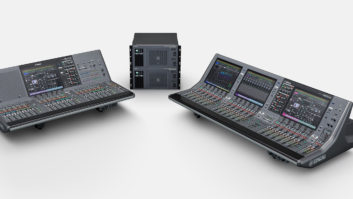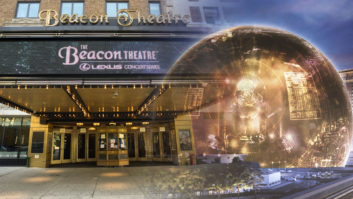
New York, NY—Taking a stage production from its standard theater setting and moving it to a sports arena would typically mean something would get lost in translation—unless you have a team of experienced engineers using the right audio technology. That scenario happened in late February when the acclaimed Broadway production of To Kill a Mockingbird took its show on the road—well, actually just a few blocks south in New York City—for a one-time performance at Madison Square Garden. The audience for the special engagement—the only Broadway production ever to be staged at the famed venue—consisted of 18,000 New York City public middle and high school students.
To call the show’s Broadway run a hit would be an understatement. The show’s producers describe To Kill a Mockingbird as the most successful American play in Broadway history, having amassed a total gross of more than $100,000,000 during its run, which, like all of Broadway, has paused during the pandemic. The show’s producers add that, since performances began on Nov. 1, 2018, To Kill a Mockingbird has not played to an empty seat at the 1,460-seat Schubert Theater. That said, all the students who filled Madison Square Garden got in for free. Tickets were handed out to schools on a first-come, first-served basis, and MSG provided the venue free of charge for the event.
While the text of playwright Aaron Sorkin’s adaptation of the classic Harper Lee novel was the same as performed nightly at the Schubert, the MSG event was still far from a typical performance. For one thing, while the show ran nightly on Broadway on a standard stage, the MSG edition was performed in-the-round on a massive 100 x 40 foot-long stage to accommodate the crowd.

A technical feat as much as a dramatic one, the re-envisioned production, which stars Ed Harris as Atticus Finch, sported a courtroom set and Finch’s porch at opposite ends of the stage. Surrounding the stage, too, were cameras that captured performances for four screens around the arena. Bringing in staging and production, load-in took place two days prior to the performance, with director Bartlett Sher and his cast using the intervening day to rehearse in their new venue, having had just eight hours a week for the previous five weeks to reinvent the play for the new location. Technical crews likewise made the most of the rehearsal day.
To compensate for the larger and more sonically challenging venue, the sound design crew used a Yamaha Rivage PM10 digital mixing console, in part because they were already familiar with the Rivage Series, having mixed the play’s regular nightly performances on a Yamaha Rivage PM7.
Yamaha EAD10 Drum Module – A Real-World Review
“This was a unique event with many different elements added, including a school choir performing at the top of the show and during intermission, and the New York City mayor speaking,” said Jamie Pollock, an independent sound engineer/designer hired by Firehouse Productions for the MSG event, “but it’s still the same show and there was an audio workflow already established. We simply loaded the PM7 show files onto the PM10 and we were ready to go. From there, I could easily build the arena show using that foundation.”
David Stollings, production sound engineer and mixer for Mockingbird’s regular run at the Shubert Theatre, added, “Since we use a Rivage console every night on Broadway, we already knew how to work quickly with this type of desk. That’s huge because there’s not a lot of time on these events for setup.”
Much like the audio team itself, the console’s mix had to adapt to the new surroundings, with adjustments made as necessary for the larger venue. A key factor was the move to a 360-degree configuration, with the audience surrounding the stage instead of a theater’s typical proscenium stage arrangement.
“With those layouts in an arena, it’s often hard to captivate the audience,” said Pollock. “It’s a totally different feeling and a different energy level. I wasn’t really sure what was going to happen, especially when you’re talking about 18,000 schoolchildren. Are they really going to listen to this? Are we going to get the point across? Will they hear all the nuances? But it turned out fabulous. We were able to capture the essence of the stage show and translate it successfully, and that’s largely due to this console.”
Another change was the use of headset boom-arm mics instead of the head-worn mics typically used in the theater. These were deployed because we “needed way more gain before feedback,” said Scott Lehrer, sound designer for Mockingbird. The team also applied the Rivage’s DaNSe plug-in for extra noise suppression to help with the feedback issue.
“Switching to booms made the process very different in terms of mixing,” said Stollings, “but using our show file, we cut out a bunch of extra cues we didn’t need, so I was still able to work in my familiar workflow.”
Pollock found the console’s use of SILK processing a time-saver. “It lets us do less EQ’ing on a lot of the input sources. Also, the layout of the desk easily accommodates multiple operators.”
Those multiple operators were a necessity, too, said Lehrer. “At Madison Square Garden, David was at the middle of the console mixing, I was on the right side tweaking the EQ, and Jamie was on the left setting up auxiliary mixes to backstage—three people all working on the same console at the same time.”
Stollings added, “Our familiarity with the Rivage surface let us accomplish what we needed to quickly. We couldn’t have done this production without the advantages we gained using this console.”
Firehouse Productions • www.firehouseproductions.com
Yamaha Professional Audio • usa.yamaha.com
To Kill a Mockingbird • www.tokillamockingbirdbroadway.com





